Aging can sure do a number on the human body but taking time for exercise is a great way to stay active, healthy, and feeling your best.
As we age, it’s natural to lose bone density, muscle mass, flexibility, and balance which can contribute to feeling hesitant towards working out; however, a consistent fitness routine is a straightforward way to combat these losses as we age.
In this article, I’ve shared 18 exercises to help seniors feel strong, flexible, and confident with age, as well as all the details one could need to complete a senior workout safely and effectively.
Senior Workout Benefits
For many older adults, maintaining mobility as we age can be a challenge. However, moving your body is ironically the best way to keep you mobile.
As the old saying goes, ‘motion is lotion’. Regular exercise and self-care can help to keep our bodies strong.
While you may think you’re starting too late in the game to make a real change, that couldn’t be further from the truth. There are some major benefits of working out at an older age, that you can experience regardless of your fitness history. Check out some of my favorites below.
Better Range of Motion & Mobility
Stretching is a great way to keep your body mobile as you age. When you stretch, you are physically lengthening your muscles. As you loosen the muscle fibers to their proper length it will help to reduce any muscle tightness or discomfort you may be experiencing and help to reduce the risk of injury.
Increase in Bone Density
Participating in weight-bearing activities like walking, strength training, or bodyweight aerobic exercises can help keep your bones strong and help with balance as well. In older age, your bone density naturally decreases, which can lead bones to be more susceptible to breaking. A broken bone can be harder to overcome in older age.
Boost Cardiovascular Fitness
By participating in a cardiovascular exercise like cycling, walking, or gardening you keep your heart and lungs healthy. Cardio is a great way to train for everyday life, it’s also a great way to reduce your risk of preventative diseases like heart disease or stroke. Perhaps my favorite cardio benefit is it’s a great mood booster! It’s easy to do outside which can be a great stress reliever and something to look forward to in your day.
Increase Strength & Muscle Mass
As we age, we lose muscle mass quickly if we don’t work to maintain it. Strength is so important for moving functionally throughout day-to-day life and can help you move through the important moments in life like chasing your grandkids around with confidence. It is possible to maintain and build strength in your older years, you just have to work on it consistently - I’d recommend at least 2 sessions a week focused on working your full body.
Improve Longevity
Finally, exercise of all kinds can increase your longevity. Who doesn’t want to be around for all those big life moments - weddings, babies, graduations, promotions, family vacations, and all the little stuff in between? Ensure you’re there for the moments that count by maintaining a regular, balanced fitness routine.
How to Safely Workout for Seniors
While you or a loved one may have concerns about you undertaking a new fitness routine, it is perfectly safe for healthy seniors to work out. Although, there are some safety considerations to consider before beginning a routine.
My first recommendation is to remember, each person starts somewhere different. Your neighbor may be stronger than you, but you may be faster than your friend down the street.
Be patient with yourself as you retrain your body and mind with a new perspective and through a new routine. Take your time as your body learns new movements and moves at new speeds and distances.
Also keep in mind, if an exercise is too challenging there are always modifications to make it easier or more practical. For example, a chair or a bench can be used to provide support, make exercises easier, and positions easier to get into with reduced risk and fear of falling.
Before you start working out, always remember to get a proper warm up in. Working out on cold muscles can result in injury, so it’s important to complete a thorough warmup, making sure your whole body is ready for what’s ahead.
In the workout below, we’ve included plenty of great warm up exercises, but I’d also recommend starting with a light walk of 5-10 minutes to help increase your heart rate as well.
Elements of an Effective Senior Exercise Routine
There are 4 essential elements to an effective senior exercise routine - which I’ve touched on briefly above - but I want to give them a home here because of how important they are. If you’re a senior just getting started on your routine and wondering what to include, here it is.
1. Flexibility
Include flexibility or stretching in your routine at least 2 days a week. Stretching is an easy way to stay mobile. It feels amazing, and it’s easy to do. All you need to do is make a little time in your routine and remember to do it.
The best time to stretch is when your body is warm, and muscles are more limber. So, after a workout is the perfect time to get some quality stretching in.
2. Strength
Strength is an incredibly important element in your fitness routine, as it will ensure you have the energy and power to do the daily activities you love to do. Include strength training in your routine at least 2 days a week, focused on working your full body - lower, upper, and core.
To complete strength training you can do bodyweight exercises, free weights like dumbbells, or even machine-based exercise. Whatever you feel challenges you, but you feel comfortable and safe completing is the right workout for you.
3. Cardio
Cardio is a crucial part of a regular healthy fitness routine. It’s recommended by the CDC that seniors get at least 150 minutes of moderate aerobic activity, or 5 days a week at 30 minutes a session. If that’s too much to start, just do what you can!
When selecting cardio to do, just remember it matters less what you do, and more that you enjoy doing it. Whether it’s gardening, playing with your grandkids, walking the dog, playing golf or tennis, hiking, or traditional cardio like using a recumbent bike - all are great options. If you’re moving and having fun while you’re at it!
4. Balance
Finally, working on your balance is important, since as you age your bones become more brittle which increases your risk of falling and getting hurt. If you lose your balance, you lose your confidence in daily life.
So, when you work out, be intentional about adding balance exercises into your routine regularly. You’ll find a few of our favorite balance exercises for seniors below.
Senior Workout Video
Ready to get moving? Try out this routine that incorporates flexibility, strength, and balance all in one go! Press play and do your best. You’re going to love Sunny Trainer James, who does a great job at providing modifications to make the workout easier, and progressions for those who are ready for more of a challenge. You got this!
Warmup Exercises for Seniors
Give these warmup moves a try, for a full body warmup.
Chin Smiles
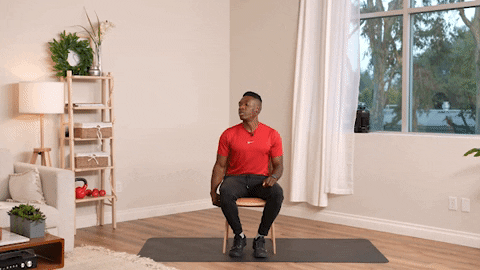
Chin Ups

Chin Tucks
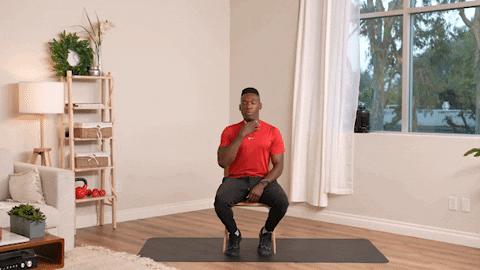
Shoulder Rolls

Trunk Rotations

Ankle Inversion
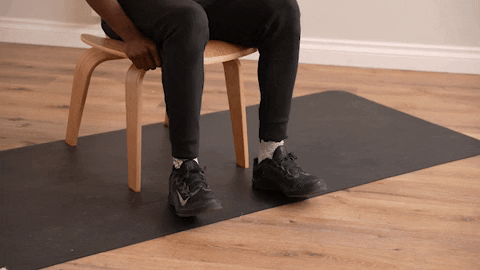
Ankle Eversion

Ankle Flexion

Ankle Extension
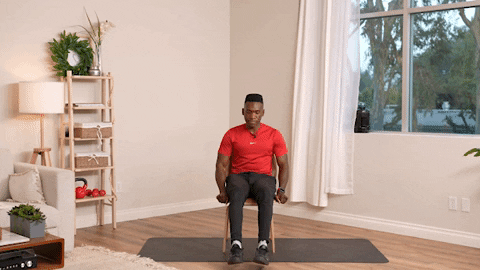
Chest Opener

Balance Exercises for Seniors
These exercises are a few of the best for working on your balance.
Tandem Walks
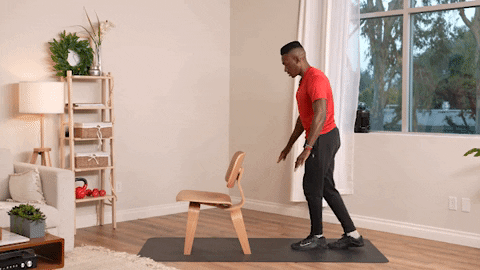
Stork Stands

Strength Exercises for Seniors
Build your strength with these 4 exercises that make for a great full body workout!
Wall Slides

Wall Push-ups

Calf Raises

Chair Squats

Mobility & Stretching Exercises for Seniors
Increase your mobility with these simple stretching exercises that will go a long way!
Standing Chest Stretch
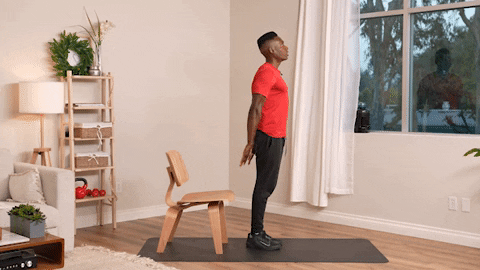
Standing Calf Stretch
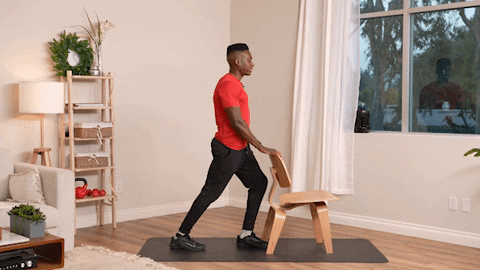
After you’ve finished your workout routine for the day, keep in mind other ways you can prioritize your health. Getting adequate rest is just as important as getting a good workout in. Ensure you’re getting at least 7 hours of sleep a night, and that’s you’re refueling your body with nutritious foods, and stay hydrated with at least 8 cups of water a day.
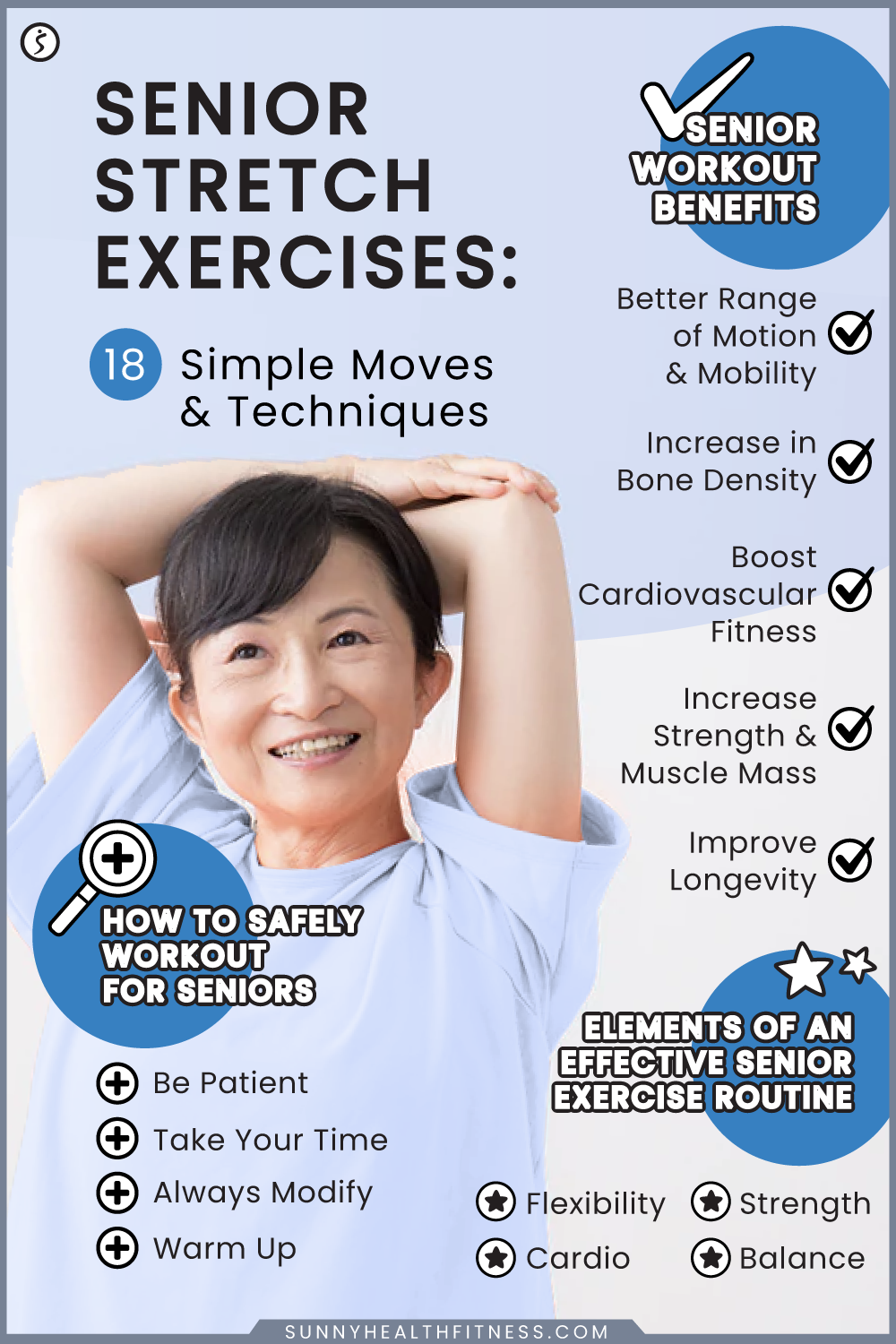















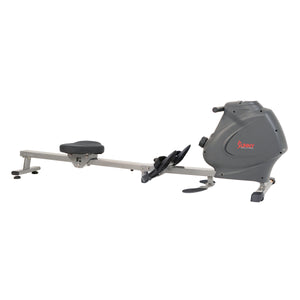










Add Your Name & Email
Please enter your name and email to continue.We won’t display your email publicly.